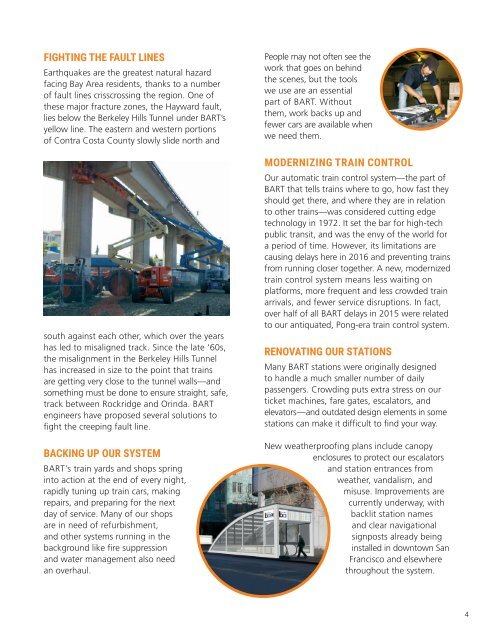IT’S TIME TO REBUILD
5qDF301rErF
5qDF301rErF
You also want an ePaper? Increase the reach of your titles
YUMPU automatically turns print PDFs into web optimized ePapers that Google loves.
FIGHTING THE FAULT LINES<br />
Earthquakes are the greatest natural hazard<br />
facing Bay Area residents, thanks to a number<br />
of fault lines crisscrossing the region. One of<br />
these major fracture zones, the Hayward fault,<br />
lies below the Berkeley Hills Tunnel under BART’s<br />
yellow line. The eastern and western portions<br />
of Contra Costa County slowly slide north and<br />
south against each other, which over the years<br />
has led to misaligned track. Since the late ‘60s,<br />
the misalignment in the Berkeley Hills Tunnel<br />
has increased in size to the point that trains<br />
are getting very close to the tunnel walls—and<br />
something must be done to ensure straight, safe,<br />
track between Rockridge and Orinda. BART<br />
engineers have proposed several solutions to<br />
fight the creeping fault line.<br />
BACKING UP OUR SYSTEM<br />
BART’s train yards and shops spring<br />
into action at the end of every night,<br />
rapidly tuning up train cars, making<br />
repairs, and preparing for the next<br />
day of service. Many of our shops<br />
are in need of refurbishment,<br />
and other systems running in the<br />
background like fire suppression<br />
and water management also need<br />
an overhaul.<br />
People may not often see the<br />
work that goes on behind<br />
the scenes, but the tools<br />
we use are an essential<br />
part of BART. Without<br />
them, work backs up and<br />
fewer cars are available when<br />
we need them.<br />
MODERNIZING TRAIN CONTROL<br />
Our automatic train control system—the part of<br />
BART that tells trains where to go, how fast they<br />
should get there, and where they are in relation<br />
to other trains—was considered cutting edge<br />
technology in 1972. It set the bar for high-tech<br />
public transit, and was the envy of the world for<br />
a period of time. However, its limitations are<br />
causing delays here in 2016 and preventing trains<br />
from running closer together. A new, modernized<br />
train control system means less waiting on<br />
platforms, more frequent and less crowded train<br />
arrivals, and fewer service disruptions. In fact,<br />
over half of all BART delays in 2015 were related<br />
to our antiquated, Pong-era train control system.<br />
RENOVATING OUR STATIONS<br />
Many BART stations were originally designed<br />
to handle a much smaller number of daily<br />
passengers. Crowding puts extra stress on our<br />
ticket machines, fare gates, escalators, and<br />
elevators—and outdated design elements in some<br />
stations can make it difficult to find your way.<br />
New weatherproofing plans include canopy<br />
enclosures to protect our escalators<br />
and station entrances from<br />
weather, vandalism, and<br />
misuse. Improvements are<br />
currently underway, with<br />
backlit station names<br />
and clear navigational<br />
signposts already being<br />
installed in downtown San<br />
Francisco and elsewhere<br />
throughout the system.<br />
4


